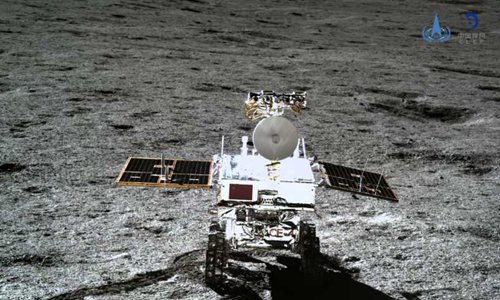Adults already doing that.
Read the articles.
Highlighting in blue for you. In addition, China has offered Chang'e-4 as a beacon for the planned US landing.
US Government and Congress should be ashamed for humiliating NASA, Their arrogant tough guy posturing at expense of science has come back bite us by demeaning a prestigious US scientific agency.
China, US work on moon
By Deng Xiaoci Source:Global Times Published: 2019/1/14 23:46:05
The photo of lunar rover Yutu II taken by lander Chang'e-4 on Friday. Photo: courtesy of China's Lunar Exploration Program
NASA has cooperated on lunar research with China's Chang'e -4 probe, a Chinese space official told the Global Times at a press conference in Beijing on Monday.
The two sides have never ceased to talk about cooperation in lunar and deep space exploration, Wu Yanhua, deputy director of the China National Space Administration (CNSA), said at a press conference organized by the State Council Information Office that outlined China's latest timetable for lunar and deep space exploration.
NASA was particularly interested in knowing how dust would move when the Chinese probe landed on the moon, Wu noted.
"In response, we immediately offered our moon-landing schedule and location to the US Lunar Reconnaissance Orbiter in lunar orbit," Wu said.
Due to a fuel shortage, the US orbiter could not change its orbit in time for the landing, but NASA observed the situation later when its satellite passed above the Chinese probe, he said.
Such cooperation was in line with humanity's shared interests, Wu said. China and the US should cooperate more in the human exploration of space, he said.
China will conduct a Mars mission by 2020 and bring a sample back from the moon in 2019, Wu said.
Thanks to the Chang'e-4 lunar probe, China has realized the first-ever soft landing on and "cruise exploration" of the far side of the moon in human history as well as the first-ever telemetry, track and command (TT&C) and data transmission between the Earth and the dark side of the moon, Wu said.
The lander and rover Yutu-2, or Jade Rabbit-2, were in good condition and had achieved their preset engineering goals, said Wu, also the deputy chief commander of the China Lunar Exploration Program.
"The Chang'e-4 lunar probe program has achieved a complete success," he said.
Data collected by domestic and international scientific payloads were downloaded normally and the Queqiao, or Magpie Bridge, relay satellite provided effective TT&C support.
The mission has moved onto its "scientific exploration phase," Wu Yanhua said.
The scientific phase has three goals, according to Wu Weiren, chief designer of China's lunar probe program.
"The primary goal is to study the geographic and geomorphic conditions of the moon," he said.
China has achieved the first cutaway view of the moon which monitors up to 200 meters underground, Wu Weiren noted.
Such a view would significantly help understanding of the origin and evolution of the moon, he explained, perhaps even reveal its true age.
The second goal is to study the space around the moon including cosmic and solar radiation and its impact on the moon, Wu Weiren said.
Finally, scientists will assess the "matter composition of the moon," he said.
"These all are firsts in human history," Wu Weiren said. "Any achievements made in these research areas will be original and have a massive influence both at home and abroad."
International efforts
International payload cooperation and joint exploration has been realized by China for the first time during the Chang'e-4 mission, Wu Yanhua said on Monday.
The Chang'e-4 probe is equipped with 13 payloads including Longjiang, a lunar microsatellite, and four scientific projects in cooperation with Germany, Sweden, the Netherlands and Saudi Arabia, according to CNSA.
The four were selected in April 2015 from applications for cooperation on 20 payloads developed by more than 10 countries to be loaded on the lander, rover, relay satellite and the lunar microsatellite, Wu Yanhua said.
A station located in Argentina has also participated in providing TT&C for the mission and the radioisotope heater units (RHUs) in cooperation with Russia, which guarantees the safety of the Chang'e-4 probe during the long, freezing lunar night.
CNSA was willing to share data collected by all payloads on Chang'e-4 with space agencies, research institutes as well as space exploration enthusiasts from all over the world, the CNSA deputy head said.
More missions
China still has unmanned Chang'e-5, -6, -7, -8 missions coming up until 2030, Wu Yanhua disclosed to the media on Monday.
Chang'e-5 will return samples from the moon in a mission scheduled for the end of this year.
Chang'e-6 will conduct a similar sample return mission, but from the south pole of the moon, he told the Global Times.
Whether the Chang'e-6 probe will land also on the far side will depend on the Chang'e-5 sample.
Chang'e-7 will comprehensively explore the moon, whereas Chang'e-8 will explore the possibility of building an international lunar research base, the CNSA deputy head said.
Chang'e-8 will test 3D printer technology in hopes of assisting future lunar residents.
As for putting humans on the moon, China is thinking about that, but no decisions have been made, Wu Yanhua said.
"China's space station is currently under construction and slated to be completed around 2022," said Li Guoping, CNSA spokesperson, at the conference.
China is inviting the international community to join in the process, enhance communication and cooperation in areas such as development of devices, space applications and astronaut training.
China also welcomes scientists from all over the globe to conduct scientific experiments at the Chinese space station, Li said.

